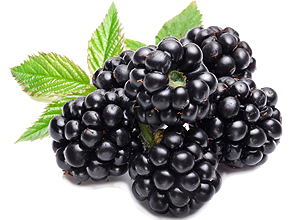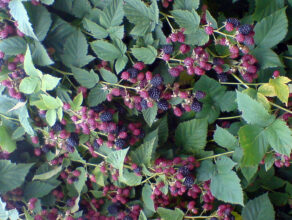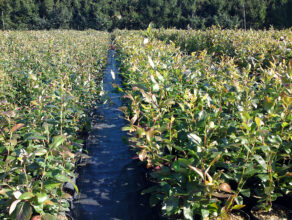Northern highbush blueberry
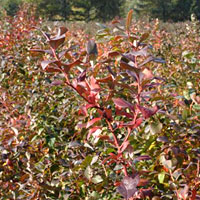
Plant comes from North America. The shrubs grow to a height of 1.3-2.0 m. They fruit after two years after planting. They grow for 20-30 years. You can get 4-8 kg from a fully fruiting shrub. They have been blooming from May 7th-10th for a period of three weeks. They withstand frosts from (-22) to (-25)°C. They can reconstruct the crown after frost damage easily. Berries are gathered in raceme, of dark blue colour with a beautiful silvery coating, with a light flesh. They are very tasty and they have high nutritional value. They are excellent for direct consumption and as frozen food and preserves.
Healing properties
Fruits are rich in sugars, pectin, tannins, many organic acids (such as citric, malic, succinic acid), vitamin C and B, minerals, trace elements and pigments (anthocyanins and carotenoids), fibre.
Tannins in fruits inhibit the growth of gastrointestinal tract pathogens thereby treat diarrhoea. They detoxify, because they have the ability to bind bacterial toxins and heavy metals. Pectin regulate intestine function, and anthocyanins contribute positively to the work of the circulatory system. The active compounds also have a calming effect on the nervous system. Recent studies have shown a very high content of antioxidants for example vitamins A, C, E and anthocyanins. They neutralize free radicals, which are the effect of environmental pollution, cigarette smoke and UV radiation. Neutralizing has anti-cancer proprieties.

Site selection
Blueberry requires permeable soil, quite humus, acidic (pH KCl 3,5-4,5), watery, sheltered from the wind and sunny. These are the most commonly forest soil.
The soil can be acidified easily with sphagnum peat or sulphur. Using a small dose of mature manure we can perfectly enrich the soil with humus and trace elements. Peat and mature manure are mixed with the top layer of soil to a depth of 40 cm and a diameter of 0.7-1.0 m. After planting and watering, the shrubs are mulched with sawdust from compost or conifers bark.
Heavier soils should be treated with sulphur, 1 year before planting shrubs, in an amount of approx. 0,5 kg / 10 m2 using one time approx. 0,1 kg (digging to a depth of 20 cm).
On heavy and alkaline soils, you should dig holes with diameter of 120 cm and a depth of 40 cm, insulate the walls with foil and fill the holes with a mixture of peat (acid), sand, composted sawdust or bark of conifers and mature manure in the ratio of 2: 1: 1: 1.
Planting date
2-3 years old material reproduced in a vegetative way in containers or with root balls should be planted in early autumn or spring. We can plant several varieties from early to late ones. We will get the fruits from mid-July to late September.
Spacing
The shrubs should be planted in plot leaving 1.5 x 1.5m of space, in large scale plantations 3.0 x 1.0 m.
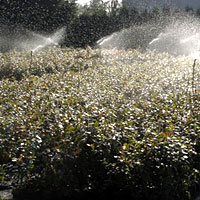
Irrigation
Immediately after planting and in the first few years of growing, the lack of water is a very limiting factor of growth and fruiting of plants. Small root system of plants requires great care in providing water. During dry seasons, we water plants with approx. 15-20l of water per 1 bush at least once a week. The most critical period for the development and planning of the plant is late spring and early summer.
Mulching
Composted sawdust, bark and needles are excellent material for mulching. Mulch provides plants with organic matter, reduces water loss and significantly reduces weeds growing. Every 2-3 years decomposed mulch should be replenished. We should be aware that while using mulches, doses of fertilizer (especially nitrogen) should be increased.
Mineral fertilization (according to SGGW instructions)
The best nitrogen fertilizer is ammonium sulfate or ammonium nitrate. 1 tablespoon for a bucket of water every 10 days, from early April to early July is the amount of nitrogen needed be the plant. Multicomponent fertilizers Mis-3, or Fructus 2 are used in an amount of:
1 year – 30g; 2 years – 30g; 3-4 years – 40-50g; 6 and further – 150g.

Cutting
Four years after planting, it is recommended to remove sick, creeping, broken and damaged by frost shoots.
From the 5th year, we should lop and crop it and rejuvenate it by cutting or shortening of the oldest shoots that are thickening the crown. We remove shoots that do not grow.
Harvesting of berries
It should be made several times in a week intervals of time. Fructification of different varieties lasts from mid-July to late September.
Cultivars (according to their time of ripening)
Early: Earliblue, Duke
Medium-early: Collins, Patriot, Spartan, Bluejay, Sunrise
Average: Bluecrop, Berkeley, Bluegold
Late: Herbert, Brigitta, Nelson, Darrow, Lateblue, Meader
Blackberry and Tayberry

Blackberry and Tayberry belong to the Rubus genus, of rose family (Rosaceae Juss), of Rosales order. They are perennial shrubs, the permanent parts of which are; the root system and the collar-root. Inflorescences are raceme or cymose. The flowers are usually monoecious. Fruits are composed of many small drupes.
Climate and soil requirements
The root system of blackberry and tayberry has high resistance to frost, however, the shoots are more sensitive. Frost pocket, as well as excessively wet or dry areas are not suitable areas for the cultivation. The best soil is that of a III and IV class with a pH of 6,0-6,5.
Planting date
1-2 years old material reproduced in a vegetative way in containers or root balls should be planted in autumn or spring. Plants can be fastened to the structure of arbour, walls and brickworks.
Spacing
On large plantations it is 3,0 x 0,5 m, on an amateur one 1,5 x 1,5 m.
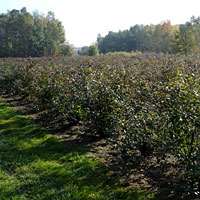
Soil preparation
Before founding plantations, you should eradicate weeds carefully. For this purpose, cultivation of plants reducing weed amount (root vegetables or brassicas) is recommended. If there is too much weed, it is advisable to use the herbicides. In order to fertilize the soil, manure, at a dose of 40-60 t/ha, can be applied. The best form of plantation soil is a herbicide fallow or covering rows with foil.
Mineral fertilization
Depending on the soil fertility: nitrogen fertilizers in a dose of 30-60 kg N /ha, potassium 40-80 kg K2O /1 ha.
Fruit Harvesting
It begins in mid-August and lasts until September.
Grapevines
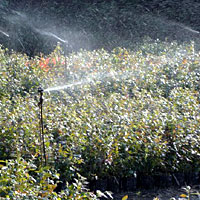
The grapevine is a long-lived plant. Root system of the shrub grows deep, its distribution depends on the structure, moisture and soil fertility. Grapevine vegetation starts late. Buds develop in late April. The largest increase of the plant is in May-July. Flowering occurs in the middle of June and lasts about two weeks. The flowers are monoecious. Fructification depends on the variety and takes place in August-October.
Climate and soil requirements
The grapevine is a thermophilic plant, it requires a long period of vegetation. It is sensitive to low temperatures in winter and spring frosts. It is a photophilous species. Grapevine has no large soil requirements. The best are light soils, humus. The pH of the soil is 6,0-7,0. The water level should not be higher than 1,5-1,8 m. The plant is relatively resistant to drought.
Planting date
Seedlings (without containers) are planted in October or early April. Plants in containers can be planted during the whole vegetation period. The best period for planting leafy seedling is May-August. Plants should be fastened to the structure.
Spacing
The distance between rows should be 1,5-3,0 m and in the row 0,8-1,8 m.
Soil Preparation
Before planting the plants, you should get rid of weeds- herbicides and improve soil fertility through adding fermented manure at a dose of 4-8 kg/m2. After planting, the best option is to prepare mechanical or herbicide fallow, litter (peat, bark or sawdust) also can be used.
Fertilization
Soils rich enough on average 100 kg dose-N, 50 kg P2O5 and 50-100 kg K2O per 1 ha (100 kg/ha, is equivalent to 10 g /1 m2).
Cutting
In order to remove the annual growth and redundant old wood, the plant must be cut. Cutting regulates the growth of the shrub and the amount of crops. The cutting method depends also on the type of the plant cultivation.
Fruit Harvesting
The grapes are harvested when they are ripe and ready to eat, because they do not ripen after they are collected from the shrub. Vinegrape bears fruit on one-year shoots. Shrubs crop first high yield in the third year after planting.




